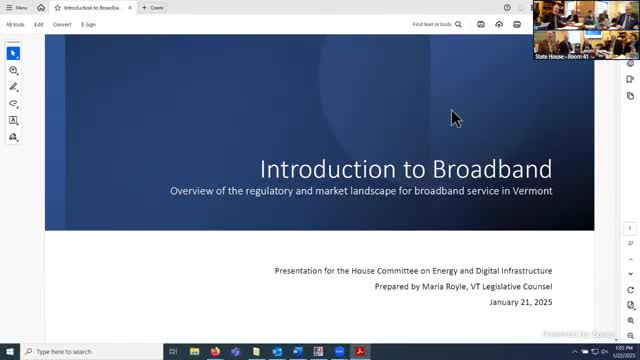Vermont aims for universal broadband access by 2024 amid ongoing connectivity challenges
January 22, 2025 | Environment & Energy, HOUSE OF REPRESENTATIVES, Committees, Legislative , Vermont
This article was created by AI summarizing key points discussed. AI makes mistakes, so for full details and context, please refer to the video of the full meeting. Please report any errors so we can fix them. Report an error »

The Vermont House Energy and Digital Infrastructure Committee convened on January 22, 2025, to address the pressing issue of broadband access across the state. The meeting highlighted the ongoing digital divide and the state's ambitious goal to ensure that every residential and business location has access to high-speed internet by the end of 2024.
Key discussions centered on defining broadband and its various forms, including DSL, cable modem, and fiber optic connections. The committee emphasized the importance of high-speed internet, particularly in light of increased remote work and digital communication needs during the pandemic. Currently, the Federal Communications Commission (FCC) defines high-speed broadband as a minimum of 100 megabits per second (Mbps) for downloads and 20 Mbps for uploads, a standard that Vermont aims to meet.
Despite these goals, the committee acknowledged that Vermont is not on track to achieve universal broadband access by the 2024 deadline. As of now, approximately half of the state has access to the desired 100/100 Mbps service, while a significant portion still relies on lower-speed connections. The discussion also revealed that about 1,100 locations in Vermont remain without any broadband service, primarily in rural areas.
The meeting further explored the historical context of broadband initiatives in Vermont, tracing efforts back to 2007. The Vermont Telecommunications Authority was established to facilitate broadband expansion, but challenges such as infrastructure costs, affordability, and regulatory hurdles have hindered progress. The committee noted that while federal funding has been available, it has not always translated into effective service delivery, with some areas still lacking adequate coverage.
In conclusion, the committee's discussions underscored the critical need for continued efforts to bridge the digital divide in Vermont. As technology evolves and funding opportunities arise, the state must navigate regulatory complexities and infrastructure challenges to ensure that all residents can access reliable and high-speed internet. The next steps will involve assessing current initiatives and exploring new strategies to meet the state's broadband goals.
Key discussions centered on defining broadband and its various forms, including DSL, cable modem, and fiber optic connections. The committee emphasized the importance of high-speed internet, particularly in light of increased remote work and digital communication needs during the pandemic. Currently, the Federal Communications Commission (FCC) defines high-speed broadband as a minimum of 100 megabits per second (Mbps) for downloads and 20 Mbps for uploads, a standard that Vermont aims to meet.
Despite these goals, the committee acknowledged that Vermont is not on track to achieve universal broadband access by the 2024 deadline. As of now, approximately half of the state has access to the desired 100/100 Mbps service, while a significant portion still relies on lower-speed connections. The discussion also revealed that about 1,100 locations in Vermont remain without any broadband service, primarily in rural areas.
The meeting further explored the historical context of broadband initiatives in Vermont, tracing efforts back to 2007. The Vermont Telecommunications Authority was established to facilitate broadband expansion, but challenges such as infrastructure costs, affordability, and regulatory hurdles have hindered progress. The committee noted that while federal funding has been available, it has not always translated into effective service delivery, with some areas still lacking adequate coverage.
In conclusion, the committee's discussions underscored the critical need for continued efforts to bridge the digital divide in Vermont. As technology evolves and funding opportunities arise, the state must navigate regulatory complexities and infrastructure challenges to ensure that all residents can access reliable and high-speed internet. The next steps will involve assessing current initiatives and exploring new strategies to meet the state's broadband goals.
View full meeting
This article is based on a recent meeting—watch the full video and explore the complete transcript for deeper insights into the discussion.
View full meeting